National Cohesive Wildland Fire Management Strategy Success Story
McMillan Spring Stewardship Fosters Healthy Forests, Improved Wildlife Habitat, Reduced Wildland Fire Risk, and Contributes to the Local Economy
Bureau of Land Management (BLM), Hanksville, Utah
Cohesive Strategy - Restore and Maintain Landscapes
2014
By Doug Page, Southwest Utah Zone Forester, BLM
Utah's Henry Mountains are a true "island ecosystem" in the middle of a desert. For some time, the mountain range was considered to have an "asbestos forest." However, in 2003 two wildfires occurred that showed this was a wrong assumption. While the Lonesome Beaver Fire (4,171 acres, lightning) had largely beneficial effects by regenerating large areas of aspen, the Bulldog Fire (31,729 acres, man-caused) burned under hotter-drier conditions causing significant damage to forests and watersheds, some of which are still recovering today. These fires brought attention to the need to manage the Henry Mountains' forests before more fires could cause more undesirable effects.
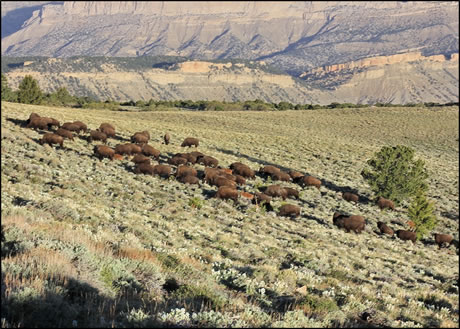
The Henry Mountains are home to a free-roaming bison herd, who are frequent visitors to the project area.
Enter the Stewardship program. Sue Fivecoat (Hanksville Field Station Manager) and Bob Bate (Richfield Field Office Fuels Specialist) enlisted the aid of Doug Page (Southwest Utah Zone Forester) to initiate planning for forest management activities on the Henrys. The first location chosen for management centered on McMillan Spring Campground and the ponderosa pine stands that surround it. Under Bob's lead, the Field Office completed the necessary NEPA to allow for treatment of up to 1,000 acres in and around the campground. BLM seasonal forestry crews conducted stand examinations in the area, and the U.S. Forest Service Forest Health Protection office provided a biological evaluation of the forest health conditions. Doug prepared silvicultural treatment prescriptions, and the Zone forestry shop did all the contract preparation. The McMillan Spring Stewardship Contract was awarded to one of Utah's best stewardship contractors, Mark Spencer of Glendale. To date Mark has completed 264 of the 525 acres under contract, with plans to complete the remainder during the 2014 operating season.
Mark Spencer, stewardship contractor said, "The McMillan Spring Stewardship Project is very important, not only because of the work that is accomplished, but because of the added value that comes with it. What I mean by this, is that the thinning and fuel reduction is done by me, the contractor, then the biomass is removed and sold. This creates another job and utilizes a renewable resource in the use of the biomass. Living in the area, means that all the money that is spent on the project for supplies, fuel, parts, and everything else, goes through the local economies. Being raised in this area gives me a sense of ownership in the project. I want it to look good and I make sure that it is done right. The Henry Mountains are amazing, and I love my office. You can't beat the view."
Dave Cook (Wildlife Biologist) joined the Hanksville team shortly after the contract was awarded. Dave has been supportive of the project and has helped guide implementation for the benefit of wildlife. Dave states: "This stewardship project has been very beneficial for wildlife habitat. It has allowed the vegetation species and structure types beneficial for wildlife for both the short and long terms. Several game and non-game birds use the ponderosa pine areas, turkeys, and Stellar jays. Many mammal species will also benefit including bison and mule deer. Seeds that produce native and useful plants for wildlife have been added to parts of the project and will benefit many types of wildlife."
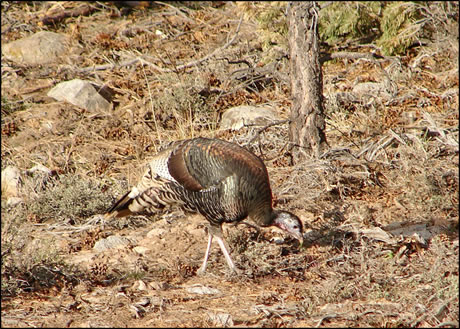
Wild turkeys are common in the project area, above a wild turkey browses through a recently thinned unit.
The project has received a lot of interest, and there is a field tour of the project scheduled for October 2014 in conjunction with the International Union of Forest Research Organizations' World Congress, which will bring foresters from around the world to Utah. Not only has this project had positive effects on the ground, it has generated interest in a mountain-wide planning effort to improve ecosystem structure and function, and interest from several non-profit organizations in a stewardship agreement for the Henry Mountains. The McMillan project provided the stepping-stone to award the Henry Mountain Habitat Partnership Stewardship Agreement in 2013 as a 10-year agreement with the Mule Deer Foundation (MDF) for continued work on the Henry Mountains where NEPA is complete or will be completed while the agreement is active. Work under this agreement is scheduled to begin during 2014, with MDF bringing matching funds of up to ¾ million dollars to the project over its 10-year lifespan.
Miles Moretti, President, Mule Deer Foundation said, "The Henry Mountain is one of the nation's premiere mule deer herds. The Stewardship Partnership between MDF and BLM is critical to keeping the habitat in a healthy condition. These types of projects help MDF meet our mission of ensuring the conservation of mule deer and their habitat."
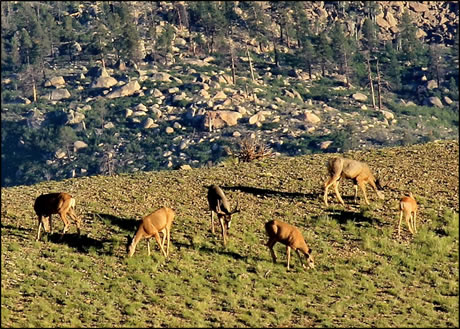
The Henry Mountains are home to a trophy mule deer population. Mule deer are commonly seen, but often only from a distance.
Silvicultural Guidelines included:
- Removal of woody vegetation that forms ladder fuels (aspen and oak excluded) that is within 1½ tree heights from the bole of ponderosa pine.
- Precommercially thin ponderosa pine sapling groups.
- Commercially thin ponderosa pine pole and small sawtimber groups.
- Retain "yellow pine" for wildlife and visual values, except trees deemed hazardous to recreation sites and roads.
- Promote aspen health and regeneration by removal of competing conifers.
- Harvest Douglas-fir and limber pine where in competition with ponderosa pine or aspen.
- Selectively thin pure and old-growth pinyon-juniper to promote uneven-aged stand conditions, reduced canopy closure, increased herbaceous understory, and reduced crown fire potential.
- Identify historic sagebrush habitat and thin trees to promote sagebrush habitat health, retaining scattered ponderosa pine, aspen, limber pine and Douglas-fir.
- Use whole juniper trees to help stabilize downcutting washes.
Three to five years after the stewardship project is complete, it will be time to reintroduce a low-intensity surface fire into the ponderosa pine stands to help maintain the more classic open conditions and fire resistance.
The following photo-pairs demonstrate before and after conditions in several portions of the project.
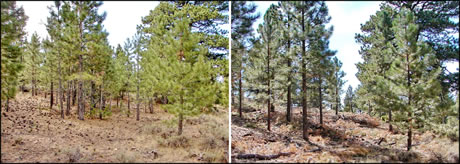
The project is pre-commercially thinning dense groups of sapling ponderosa pine to promote increased health and growth of the residual trees.
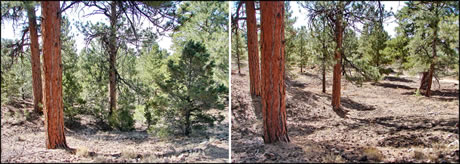
Vegetation (mostly pinyon and juniper trees) that forms ladder fuels below and adjacent to ponderosa pine is being removed and products are being used for fuelwood.
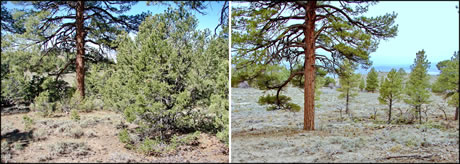
Historically sagebrush habitat (with scattered trees) was more common. The project is "restoring" much of such habitat.
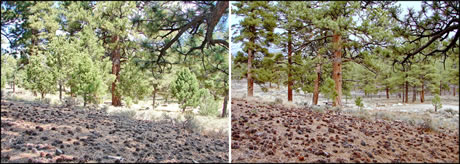
Thinning and ladder fuel reductions have also been completed in McMillan Spring Campground to improve aesthetics and to reduce the risk of crown fire and tree loss.